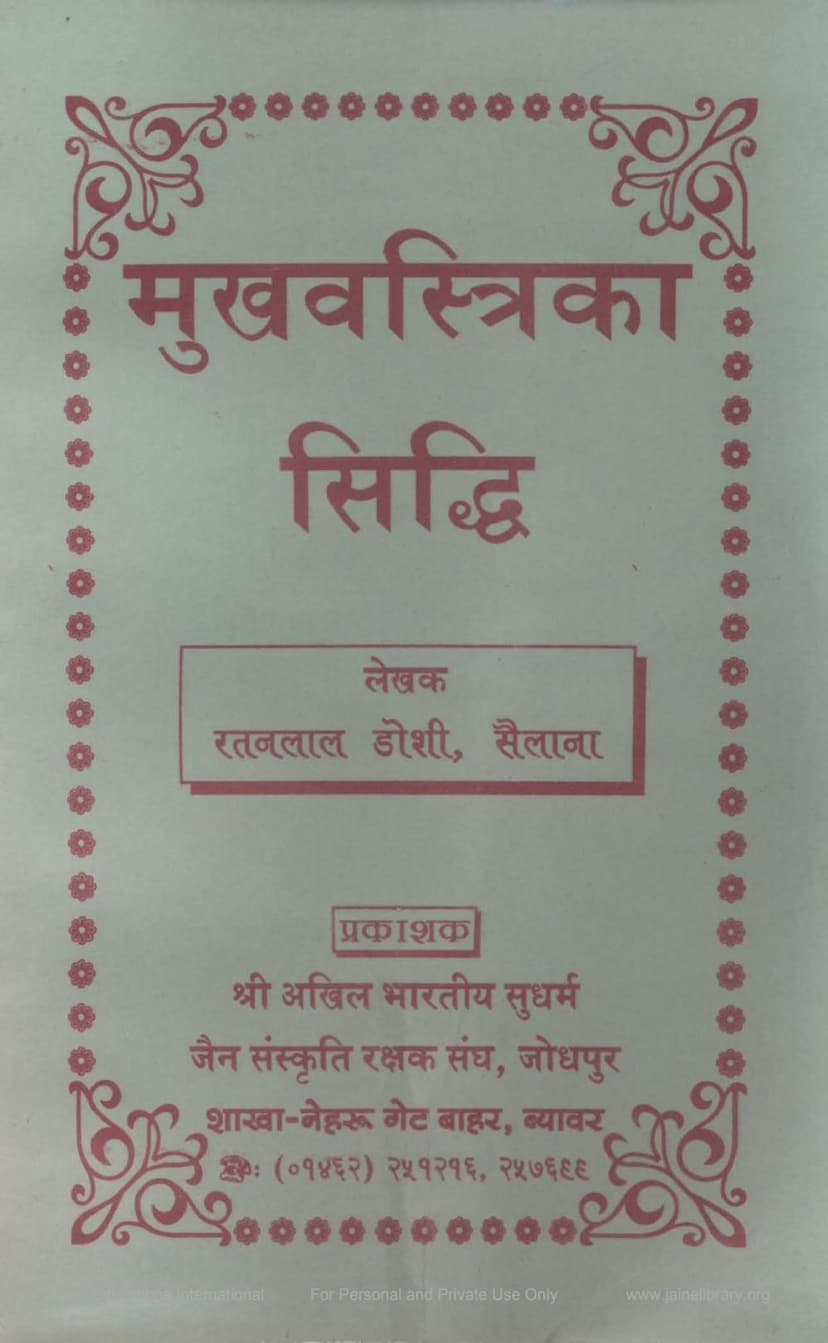Mukhvastrika Siddhi
Added to library: September 2, 2025

Summary
This document is the Hindi text of the Jain book "Mukhvastrika Siddhi" by Ratanlal Doshi, published by Akhil Bharatiya Sudharm Jain Sanskruti Rakshak Sangh. The catalog link provided is for the JainQQ website.
The book focuses on the importance and practice of wearing a mukhvastrika (a piece of cloth worn over the mouth and nose) for Jain monks and nuns, as well as lay followers.
Here's a comprehensive summary of the key points discussed in the provided pages:
Core Argument: The primary purpose of the book is to assert and prove the absolute necessity of wearing a mukhvastrika at all times for Jain monks and nuns, and during religious practices for lay followers. The author vehemently argues against the practice of keeping the mukhvastrika in the hand or discarding it during specific times, which he attributes to "Shithilachar" (laxity or decay in religious practice).
Key Reasons for Wearing Mukhvastrika:
-
Protection of Life (Ahimsa):
- Jainism emphasizes Ahimsa (non-violence) towards all living beings, including subtle, invisible ones like Vayukaya (air-bodied) beings.
- The author asserts that the breath exhaled from an uncovered mouth can harm Vayukaya beings. Therefore, wearing the mukhvastrika is crucial to fulfill the great vow of Ahimsa completely.
- The text cites various scriptures and interpretations to demonstrate that the breath, even when expelled through a mouth covered only by a hand, can still cause harm. The mukhvastrika, especially an eight-layered one, is presented as the most effective barrier.
-
Symbol of Jain Sadhutva (Monkhood):
- The mukhvastrika is presented as a distinctive marker or "ling" (symbol) of a Jain monk or nun.
- Wearing it makes Jain ascetics recognizable to people of other faiths, distinguishing them clearly.
- The author quotes scriptures, including the Shiva Purana, which describes Jain ascetics as those who wear a cloth on their mouth ("Tundye Vastrasya Dharakah").
Historical and Scriptural Basis:
- The book argues that the practice of wearing the mukhvastrika is deeply rooted in Jain scriptures and ancient tradition.
- It states that even Achalaka and Jinkalpi monks, who renounce all possessions including clothing, were mandated to wear the mukhvastrika.
- The author critically examines various Jain scriptures like Acharaanga, Bhagwati Sutra, Mahanishith Sutra, Dashavaikalika, and others to support his claims.
- He references historical events, such as the "Nabha-Shastrarth" (debate in Nabha) where a Jain monk's victory in a debate about the mukhvastrika is highlighted.
Critique of Opposition and Laxity:
- A significant portion of the book is dedicated to refuting the arguments of those who advocate for keeping the mukhvastrika in hand or argue against its constant wear.
- The author strongly criticizes individuals like Gyan Sundarji, whom he accuses of having ulterior motives (like revenge for excommunication) and spreading misinformation to support the lax practice.
- He debunks arguments that the breath does not harm Vayukaya beings, or that the mukhvastrika is only for show, or that saliva creates new life forms on a wet mukhvastrika.
- The book traces the decline in the practice from constant wear to wearing it only during specific occasions and finally to considering it a sin to wear it. This decline is attributed to "Shithilachar" (laxity).
- The author also addresses interpretations of scriptures that opponents use to justify their stance, showing how these interpretations are either misconstrued or misapplied. For instance, the use of hand to cover the mouth during sneezing or yawning in Acharaanga is explained as a specific measure for intense expelled breath, not a replacement for the mukhvastrika.
For Lay Followers (Shramanupasak):
- The book also emphasizes the importance of wearing a mukhvastrika or an uttarasanga (a shoulder cloth covering the mouth) for lay followers when visiting monks and nuns or during religious observances like Samayika. This is based on scriptural injunctions to avoid speaking with an open mouth.
Structure and Content:
- The book is divided into various sections, including "Vinay" (humility), "Mithya-Abhimaan Mahima" (glory of false pride), discussions on the Nabha debate, reasons for wearing the mukhvastrika, and detailed scriptural proofs and refutations of opposing arguments.
- It includes numerous quotes from Jain scriptures and commentaries, as well as references to historical events and opinions of prominent Jain monks.
- The author uses a direct and assertive tone to defend the traditional practice.
Publication Details:
- The book was first published in Vikram Samvat 1964 and the second edition in 1968. This edition (2002) is a reprint after a long gap.
- The publication is supported by generous donors, highlighting the importance the community places on this issue.
In essence, "Mukhvastrika Siddhi" is a strong defense of a fundamental Jain practice, aiming to correct what the author perceives as deviations from the true path of Jainism by re-emphasizing scriptural authority and historical tradition.